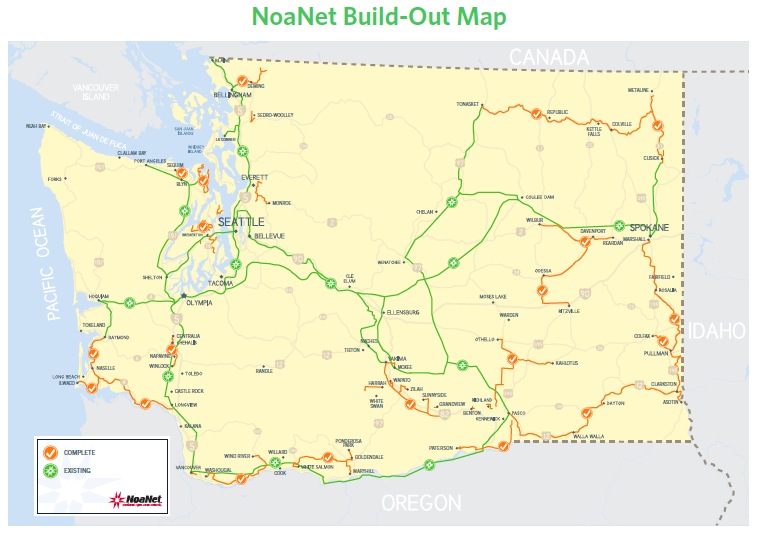WASHINGTON STATE BROADBAND OFFICE
For the broadband ecosystem of Washington State, 2013 was a year of getting up to speed. Most of the major infrastructure projects funded through the American Recovery and Reinvestment Act were completed during the year. The largest of these projects was construction of more than 1,300 miles of “middle mile” fiber optic cable. Middle mile infrastructure usually connects communities at several key spots and the connection to a residence or business is considered “last mile” (for an explanation of broadband terms and technology please see Guide to Terminology and Technology on page 29).
Private investment continued throughout 2013 as well. Large wireline providers Frontier and CenturyLink spent millions on upgrades to existing service and expansion as did the smaller providers who are members of the Washington Independent Telecommunications Association. And the nation’s wireless giants Verizon and AT&T expanded their 4G service areas, particularly in Northeastern Washington (see speed comparison maps on page 32 of this report).
Washington’s tribal communities also went to work improving access to broadband on tribal lands. In some cases the tribes leveraged their own income sources to set up wireless or fiber networks to connect traditionally unserved or underserved communities to the Internet. The Confederated Tribes of the Colville Reservation used United States Department of Agriculture (USDA) Community Connect funds to install more fiber and will improve the network’s redundancy as well as add a public computing center before the project is complete.
The resulting improvement of broadband access across the state is impressive. The National Broadband Map compiles data from all 56 states and territories and includes tools for analysis and ranking of broadband access across the nation. Washington is ranked 22nd in the nation for access at download 3 Mbps or better download (98.9 percent of our state’s population has access at this speed tier). However at higher speed tiers we shine, for instance 94 percent of Washingtonians have access to 100 Mbps or better. At that tier we are fourth in the nation, only two slots behind Massachusetts and well ahead of California.
And Washington’s own map2 data analysis shows that more than 450 of Washington’s 629 census places (which include incorporated and unincorporated communities) saw an increase in broadband access, broadband speed or both between June of 2012 and June of 2013. For many of these communities it was the second upgrade in speed or coverage in two years as 500 census places saw increases last year.
Ultimately improved broadband service does not by itself create jobs or improve a community’s quality of life. The key to improving those statistics lies in adoption or use of broadband’s full potential. During 2013, the Washington State Broadband Office continued its work to encourage the realization of broadband’s potential, in part through two key initiatives.
- The second year of funding of more than $300,000 in Local Technology Planning Team grants went to six community organizations representing multiple towns, counties and more than a dozen tribal communities. They are engaged in a variety of broadband activities from basic community surveys to hands-on education with iPads.
- The Broadband Office in partnership with the Technology Alliance expanded the scope of its apps contest with activities that engage our education community, including a K-12 Algebra Challenge, the ADA Academy that develops programming skills of adult women, and the first U.S. trial of the Apps for Good program from the United Kingdom.
These efforts help the state head in the right direction. And they build on the momentum of a tech industry sector that is already robust. But they do not ensure a prosperous technology powered future. There are however, policy choices that can help Washington create its own future of innovation.
Download full version (PDF): Broadband in Washington
About the Washington State Broadband Office
broadband.wa.gov
“The Washington State Broadband Office was created in November of 2009 through a five-year grant as part of the American Recovery and Reinvestment Act (ARRA). The office is charged with coordination, programming, and outreach on broadband issues in the state. The total federal funding for the program is $7.3 million administrated by the National Telecommunications and Information Administration (NTIA) through the Broadband Technology Opportunities Program (BTOP).”








 RSS Feed
RSS Feed